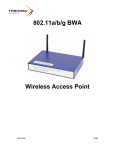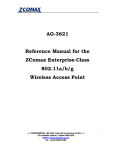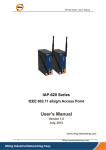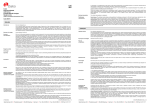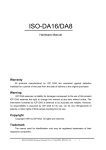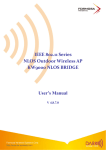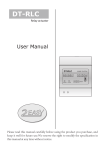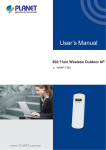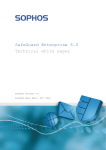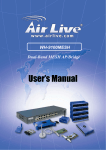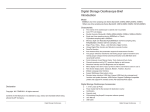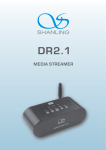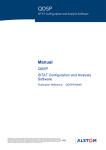Download - Formosa Wireless Systems Corp
Transcript
IEEE 802.11 Series KWO-5000 High Performance Outdoor Bridge User’s Manual V1.1.11.0 KWO5000 1. Copyright There is no any clear or implicit assurance in the user's manual of our company, including the assurance of selling or installing for the special purpose. There are rival's volumes to carry on the power to alter or revise in our company, if alter and forgive me for not issuing a separate notice. You can’t duplicate any content of this manual by the written permission of our company. 2. About the manual The purpose to use this manual is for install the wireless Access Point. This manual is including disposing course and method and helping the customer to solve the unpredictable problem. The following typographical conventions are used in this purpose: Notice: This indicates an important Note. Warning : This indicates a warning or caution. Bold: Indicates the function, important words, and so on. Content Chapter 1. Introduction ................................................................................................ 7 Overview...................................................................................................................... 7 Key Features ................................................................................................................ 8 Typical Infrastructure................................................................................................... 9 Typical Case............................................................................................................... 11 Chapter 2. Basic Installation ...................................................................................... 12 System Requirements................................................................................................. 12 Hardware Description ................................................................................................ 12 Installing KW5000 Access Point ............................................................................... 12 Hardware Installation.................................................................................................. 13 Configuring the TCP/IP Settings of Your PC.............................................................. 13 KWO5000 Checking Your LAN Connections ................................................................................ 15 Installing Your KW5000 AP with a Web Management................................................. 15 Operating Distance Tips ............................................................................................... 17 Chapter 3. Basic Configuration.................................................................................. 19 Default Factory Settings............................................................................................... 18 How to Enter Your KW5000 Management Web.......................................................... 18 Basic Information about the KW5000 ......................................................................... 19 Wireless Information about the KW5000 .................................................................... 21 Chapter 4. Advanced Settings .................................................................................... 23 Understanding RADIUS Settings ................................................................................ 23 Getting To Know KW5000 Wireless Security Options................................................ 24 Security Precautions ..................................................................................................... 24 Wireless Security Options............................................................................................. 25 Time Server .................................................................................................................. 27 Bridge/Router Mode .................................................................................................... 28 Any IP .......................................................................................................................... 30 HTTP Redirect ............................................................................................................. 30 Firewall Management .................................................................................................. 31 Virtual Server ............................................................................................................... 33 VAP / VLAN ................................................................................................................ 34 Super Mode (A / G)...................................................................................................... 35 Wi-Fi Multi-media (WMM)......................................................................................... 36 Load balance ................................................................................................................ 37 Smart WDS .................................................................................................................. 37 Build Your Wireless Infrastructure via KW5000 ......................................................... 38 Wireless Access Point Mode......................................................................................... 38 KWO5000 Station Adapter Mode ................................................................................................... 39 Wireless Bridging Mode ............................................................................................... 39 Wireless Repeater Mode ............................................................................................... 41 Wireless Inter-building Mode ....................................................................................... 42 Chapter 5. Management................................................................................................ 43 Site Survey ................................................................................................................... 43 View Statistics Information.......................................................................................... 44 View Station Information............................................................................................. 45 Change Password ......................................................................................................... 46 Remote Management ................................................................................................... 46 SSH .............................................................................................................................. 47 SNMP........................................................................................................................... 49 Upgrade Firmware ....................................................................................................... 52 Backup / Restore Settings ............................................................................................ 53 Event Log..................................................................................................................... 54 Reboot AP .................................................................................................................... 55 Chapter 6. Troubleshooting .......................................................................................... 56 Content of Figure Figure 1 Wireless Point-to-multi-point .......................................................................................... 9 Figure 2 Wireless Point-to-Point.................................................................................................. 10 Figure 3 Wireless Repeater .......................................................................................................... 10 Figure 4 Wireless Access Point.................................................................................................... 11 Figure 5 Wireless network Connection properties ....................................................................... 14 Figure 6 Internet Protocol (TCP/IP) Properties ........................................................................... 14 Figure 7 Ping Reply ..................................................................................................................... 15 KWO5000 Figure 8 KWO5000 log in window.............................................................................................. 16 Figure 9 KWO5000 General Information .................................................................................... 16 Figure 10 Safety Alert.................................................................................................................. 19 Figure 11 Radius settings............................................................................................................. 23 Figure 12 KWO5000 access control ............................................................................................ 25 Figure 13 Basic settings ............................................................................................................... 27 Figure 14 WAN/LAN settings...................................................................................................... 28 Figure 15 Router Mode—WAN at Ethernet Port......................................................................... 29 Figure 16 Router Mode—WAN at Wireless Port......................................................................... 29 Figure 17 Router Mode-WAN at Ethernet Port............................................................................ 29 Figure 18 Router Mode-WAN at Ethernet Port............................................................................ 30 Figure 19 HTTP Redirect settings................................................................................................ 31 Figure 20 Firewall management .................................................................................................. 32 Figure 21 Firewall list.................................................................................................................. 33 Figure 22 Virtual server management .......................................................................................... 34 Figure 23 VLAN .......................................................................................................................... 35 Figure 24 Wireless Access Point.................................................................................................. 38 Figure 25 Wireless Station Adapter.............................................................................................. 39 Figure 26 WDS Mode .................................................................................................................. 40 Figure 27 Wireless Point to Multi-Point Bridge .......................................................................... 41 Figure 28 Wireless Point-to-Point Mode ..................................................................................... 41 Figure 29 Wireless Repeater Mode.............................................................................................. 42 Figure 30 Site Survey................................................................................................................... 43 Figure 31 Link Test ...................................................................................................................... 44 Figure 32 Statistics Information................................................................................................... 45 Figure 33 Connection status......................................................................................................... 45 KWO5000 Figure 34 Change Password......................................................................................................... 46 Figure 35 Remote Management................................................................................................... 47 Figure 36 SSH.............................................................................................................................. 48 Figure 37 Command .................................................................................................................... 49 Figure 38 Get Mib File ................................................................................................................ 50 Figure 39 MIB Compiler ............................................................................................................. 51 Figure 40 MIB File ...................................................................................................................... 52 Figure 41 Backup......................................................................................................................... 54 Figure 42 Event log...................................................................................................................... 55 Figure 43 Reboot AP.................................................................................................................... 55 Content of Table Table 1 KWO5000 Default Settings............................................................................................ 18 Table 2 Wireless Advanced Settings ............................................................................................ 22 Table 3 Security ........................................................................................................................... 27 KWO5000 Chapter 1 Introduction Introduction Thank you for choosing the Formosa’s KWO5000 Access Point (hereafter called access point). This Access Point provides a secure, affordable, and easy-to-use wireless LAN solution that combines mobility and flexibility with the enterprise-class features required by networking professionals. Overview 802.11a/b/g-compliant, this access point distinguishes herself by one built-in mini-PCI card, providing wired and wireless two ports in a bigger infrastructure. Typically, VAP functionality allows a single network AP to behave as “8” number of virtual network APs. This does away with the limitation by the sheer number of Ethernet connections that need APs acting as a proxy. WMM prioritizes traffic demands from different applications and extends Wi-Fi’s high quality end-user experience from data connectivity to voice, music, and video applications under a wide variety of environment. This Access points serves as the connection point between wireless and wired networks or as the center point of a stand-alone wireless network. In large installations, wireless users within radio range of an access point can roam throughout a facility while maintaining seamless, uninterrupted access to the network. You can configure and monitor the access point using the command-line interface (CLI), the browser-based management system, or Simple Network Management Protocol (SNMP). This Access Point currently can support data rate up to 108Mbps. Users are encouraged to update their latest firmware through http://www.tw-wireless.com Networks are useful tools for sharing computer resources. You can access one printer from different computers and access data located on another computer's hard drive. Networks are even used for playing multiplayer video games. So, networks are not only useful in homes and offices, they can also be fun. Use the instructions in this Guide to help you connect the Access Point, set it up, and configure it to bridge your different networks. These instructions should be all you need to get the most out of the Access point. KWO5000 Key Features The KWO5000 Access Point is use-friendly and provides solid wireless and networking support. The following standards and conventions are supported: Standards Compliant The Wireless Access Point complies with the IEEE 802.11a/b/g for Wireless LANs. WEP support Support for WEP including 64-bit, 128-bit, and 152-bit keys. DHCP Client Support DHCP Server provides a dynamic IP address to PCs and other devices upon request. The KWO5000 can act as a client and obtain information from your DHPC server. SNMP Support Support for Simple Network Management Protocol (SNMP) Management Information Base (MIB) management. Multiple operating modes Access point Station Adapter Point-to-Point Bridge. Wireless Repeater Inter-building Repeater mode Configure the access point as a wireless repeater to extend the coverage area of your wireless network. VAP Assign Multi-SSIDs on your access point (one SSID per VAP) to differentiate policies and services among users forming a wide variety of VLANs. QoS Use this feature to support quality of service for prioritizing traffic from the Ethernet to the access point. The access point also supports the voice-prioritization schemes used by 802.11a/b/g wireless phones. Transmit Power Control Supports settable transmit power levels to adjust coverage cell size, ranging from full, half(50%), quarter(25%) eighth(12.5%0 and min Atheros Super Mode(A/G) Super mode enables the transmission up to 108Mbps Multiple security settings per VLAN with up to 8 VLANs Security settings for multiple groups – so employees, guests and contractors now easily and securely share the same infrastructure KWO5000 Access Control. The Access Control MAC address filtering feature can ensure that only trusted wireless stations can use the KWO5000 to gain access to your LAN. Hidden Mode The SSID is not broadcast, assuring only clients configured with the correct SSID can connect. Typical Infrastructure The KWO5000 Access Point proves to be a highly competent device, undertaking various tasks for your different environments. We’ll spell out the applicability below. Wireless Point-to-Point The wireless Point-to-Point mode features connecting two sub-networks far away, allowing ou to quickly and cost-effectively have access to the internet in a matter of minutes. Figure 1 Wireless Point-to-multi-point Under this mode, the KWO5000 plays the leading role in the infrastructure, connecting devices apart. KWO5000 Figure 2 Wireless Point-to-Point Wireless Repeater When the other AP is several thousands miles away form the KWO5000, the repeater mode is strongly recommended. Figure 3 Wireless Repeater Wireless Access Point This mode is typically for mobile environments. KWO5000 Figure 4 Wireless Access Point Typical Case The high-quality performance enables the KWO5000 to gain widespread acknowledgements. It is able to undertake tasks in various situations. Create or expand well-created network via the KWO5000 in enterprises or residential quarters Provide an access to Metropolitan Area Network via WLAN Act as a media connecting Base Station and sub-stations in mobile communicating network Provide an access to hard-to-reach areas, like historical sites Build a makeshift network for a meeting Link Backup or Emergency Communication KWO5000 Chapter 2 Basic Installation System Requirements Before installing the KWO5000 access point, make sure your system meets these requirements. The Category 5 UTP straight through Ethernet cable with RJ-45 connector included in the package, or one like it. A 110 V, 60 HZ AC power source. A Web browser for configuration such as Microsoft Internet Explorer 6.0 or above, or Netscape Navigator 4.78 or above. At least one computer with the TCP/IP protocol installed What’s In the Box? Formosa Wireless Access Point 802.11a/b/g KWO5000 Enjector-N KWO5000 11a/b/g Wireless Access Point Installation Guide Resource CD for the Formosa KWO5000 Wireless Access Point Hardware Description We’ll discuss the KWO5000 front and rear functions. Installing KWO5000 Access Point Before installing, you should make sure that Ethernet network is perfectly working. You will be connecting the KWO5000 to the Ethernet network so that computers with 10/100 Fast Ethernet adapters will communicate computers on the Ethernet. Set Up the KWO5000 Access Point Tip: 1. Before mounting the KWO5000 in a high location, first set up and test the KWO5000 to verify wired network connectivity. 2. Prepare a computer with an Ethernet adapter. If this computer is already part of your network, KWO5000 record its TCP/IP configuration settings. 3. Configure the computer with a static IP address of 192.168.1.x (x cannot be 1)and 255.255.255.0 for the Subnet Mask. Please follow the steps below to complete installing of your KWO5000. Hardware Installation 4. Combine the external antennas into the antenna connector. Note Make sure that you connect tightly the External antenna on the antenna connector of your KWO5000 AP. A loosen antenna will reduce the radiant energy or even lose it. In order to improve the RF signal radiation of your antenna, proper antenna placement is necessary. Try to place the antenna as high as possible to increase the coverage area. Connect one end of an Ether cable to the KWO5000 AP and connect the other end to the Ethernet LAN port located on your PC. Turn on your computer, connect the power adapter to the KWO5000 and verify the following: The PWR power light goes on. The LAN light of the wireless access point is lit when connected to a powered on computer. Configuring the TCP/IP Settings of Your PC Make sure the TCP/IP protocol has been installed in your PC. Please take the KWO5000 following steps to set a static IP address in Windows XP/2000. 5. Go to StartÆClick control PanelÆDouble-click Network ConnectionsÆRight-click Local Area ConnectionÆClick Properties Highlight Internet Protocol (TCP/IP) and click Properties. Figure 5 Wireless network Connection properties Select Use the following IP address in the Internet Protocol (TCP/IP) Properties window. Set your IP address and subnet mask. Configure a static IP address of 192.168.1.x (x cannot be 1) and 255.255.255.0 for the Subnet Mask. Then click OK button. Figure 6 Internet Protocol (TCP/IP) Properties KWO5000 Checking Your LAN Connections Please follow the steps below to check whether your LAN connection is OK, by using “Ping” command. 6. Click Start.ÆProgramsÆAccessoriesÆCommand Prompt 7. Under MS-DOS, you can use “ping” to check whether your computer has been successfully associated to your KWO5000. 8. Execute the ping command: ping 192.168.1.1 If the connections between your AP and PC is OK, the reply will appear below. Figure 7 Ping Reply Installing Your KWO5000 AP with a Web Management 9. Connect to the KWO5000 by opening your browser and entering http://192.168.1.1 in the address field. A login window like the one shown below opens: KWO5000 Figure 8 KWO5000 log in window 10. When prompted, please enter admin for Name and password for password, both in low cases. 11. Clicking Login now, it will navigate you into KWO5000’s homepage-----General Information will be shown below. Figure 9 KWO5000 General Information KWO5000 Operating Distance Tips The range of your wireless connection is significantly determined by the physical placement of the access point. To optimize the results, place your wireless access point: Near the center of the area in which your PCs will operate. In an elevated location such as a high shelf where the wirelessly connected PCs have line-of-sight access (even if through walls). Away from sources of interference, such as PCs, microwaves, and 2.4 GHz / 5.8GHz cordless phones. • Away from large metal surfaces. Putting the antenna in a vertical position provides best side-to-side coverage. Putting the antenna in a horizontal position provides best up-and-down coverage. If using multiple access points for 2.4GHz 802.11g mode, it is better if adjacent access points use different radio frequency Channels to reduce interference. The re commended Channel spacing between adjacent access points is 5 Channels (for example, use Channels 1 and 6, or 6 and 11). KWO5000 Chapter 3 Basic Configuration Default Factory Settings We’ll elaborate the KWO5000 default factory settings. You can re-acquire these parameters by resort button. If necessary, please refer to the “the way to restore default factory settings. FEATURE FACTORY DEFAULT SETTINGS User Name (case sensitive) Admin Password (case sensitive) Password Access Point Name APxxxxxx(xxxxxx represents the last 6 digits of MAC address) Country / Region United States Router Mode Bridge IP Type static IP IP Address 192.168.1.1 IP Subnet Mask 255.255.255.0 Default Gateway 0.0.0.0 Operating Mode Access Point Wireless Mode 802.11a or 802.11b/g Channel / Frequency 52 / 5.260GHz or channel 6 Table 1 KWO5000 Default Settings How to Enter Your KWO5000 Management Web KWO5000 provides you with user-friendly web-based management. Take the following steps When entering the IP address: http://192.168.1.1, you’ll see a popup menu below: KWO5000 Figure 10 Safety Alert 12. Clicking “Yes” ushers you into the login. Note: Make sure the PC IP address need to be matched the AP. For instance, the KWO5000 is 192.168.1.1, and your PC IP should be 192.168.1. X. 13. Enter the default name “admin” in the username field and “password” in the password field。 Clicking “Login now”will usher you into the KWO5000 management interface. Basic Information about the KWO5000 We’ll elaborate the information from the KWO5000 homepage. Access Point Name You may assign any device name to the Access Point. This name is only used by the Access Point administrator for identification purposes. Unique, memorable names are helpful, especially if you are employing multiple access points on the same network. The default name is APxxxxxx. MAC Address MAC Address is short for Media Access Control address, a hardware address that uniquely identifies each node of a network. Country/Region identified in this field. The default country is the United States. Firmware Version KWO5000 Firmware is stored in a flash memory and can be upgraded easily, using your Web browser, and can be upgraded via ftp server or ftp server. The currently available version of KWO5000 is 1.1.11.0. IP Type By default, the KWO5000 is configured as static IP Address. IP Address: The IP address must be unique to your network. The default IP address is 192.168.1.1. Note To associate the access point to your PC, make sure the PC IP address need to be matched the AP. For instance, the KWO5000 is 192.168.1.1, and your PC IP should be 192.168.1. X. Subnet Mask The Subnet Mask must be the same as that set on the LAN that your Access Point is connected to. The default is 255.255.255.0. Operating Mode KWO5000 provides five modes, Access Point, Station, bridge, repeater and inter-building. Access Point: Act as a standard 802.11a/b/g. The default mode is Access Point. Station: Perform as a client station associated to other APs. Be sure that they share the same SSID when connected. Bridge The KWO5000 acts as a bridge connecting APs. Two bridge modes are available below. Point-to-Multi-Point Bridge Select this only if this KWO5000 is the “Master” for a group of bridges. The other bridge must use this KWO5000 MAC address. They then send all traffic to this “Master”, rather than communicate directly with each other. WEP should be used to protect this traffic. Wireless Repeater In this mode, the KWO5000 can communicate with another wireless station or wireless bridge. You can enter the MAC address of both adjacent repeaters in the fields provided to communicate with other wireless bridge or use SSID to communicate with other wireless station. WEP should be used to protect this communication. Wireless Mode: Select the desired wireless operating mode. The default mode is 802.11a / KWO5000 802.11bg Channel This field identifies which operating frequency will be used. Security Profiles This provides a list of virtual APs derived from KWO5000 Virtual AP, spelling out profile name, SSID, MAC, security, and status. Build Wireless Point-to-Point Bridge Mode Under this mode, two separate networks located apart can be connected to carry out data-transmission about several thousand miles away Create a connection between AP and wireless station separately. Open the KWO5000 management web through entering the default factory IP Address 192.168.1.1, user name—admin and password—password. Enter the other AP’s name on the MAC address field, respectively, Wireless Information about the KWO5000 The following describes the advanced wireless parameters. Field Description RTS Threshold The packet size used to determine whether it should use the CSMA/CD (Carrier Sense Multiple Access with Collision Detection) or the CSMA/CA (Carrier Sense Multiple Access with Collision Avoidance) mechanism for packet transmission. Fragmentation Length This is the maximum packet size used for fragmentation. Packets larger than the size programmed in this field will be fragmented. The Fragment Threshold value must be larger than the RTS Threshold value. Beacon Interval Specifies the data beacon rate between 20 and 1000. DTIM Interval The Delivery Traffic Indication Message specifies the data beacon rate between 1 and 255. Preamble Type A long transmit preamble may provide a more reliable connection or slightly longer range. A KWO5000 short transmit preamble gives better performance. Long is the default Antenna Select the desired antenna for transmitting and receiving. Auto is the default. Ap flow control Ap flow control 1 to 1687 AP Auto Channel Auto channel setting Table 2 Wireless Advanced Settings KWO5000 Chapter 4 Advanced Settings The KWO5000 access point is a highly competent device, providing applicable functions. Understanding RADIUS Settings RADIUS is a server for remote user authentication and accounting. It can be used on any network that needs a centralized authentication and/or accounting service for its workstations. From the system Setup, click Radius Settings, the RADIUS Settings will display as below. Figure 11 Radius settings You will also have to fill in the following Radius server settings: Primary Radius Server IP Address This field is required. Enter the IP address of the Radius Server on your LAN or WAN.. Secondary Radius Server IP Address This field is optional. Enter the IP address of the Secondary Radius Server on your LAN. KWO5000 Radius Port Enter the port number used for connections to the Radius Server. Radius Shared Key Enter the desired value for the Radius shared key. This key enables the KWO5000 to log in to the Radius server and must match the value used on the Radius server. Radius Accounting Option The Radius Accounting option can be enabled so that you can track various information like who connected to the network, when they connected, how long they were connected, how much network traffic they generated, and so on. Note: The RADIUS setting integrate accounting RADIUS login. About RADIUS setting is to see Microsoft server step-by-step guide for setting up secure . Getting To Know KWO5000 Wireless Security Options Formosa wants to make wireless networking as safe and easy for you as possible. The current generation of Formosa products provides several network security features, but they require specific action on your part for implementation. So, keep the following in mind whenever you are setting up or using your wireless network. Security Precautions The following is a complete list of security precautions to take as shown in this User’s Manual. (at least steps 1 through 5 should be followed): 1. Change the default SSID. 2. Disable SSID Broadcast. 3. Change the default password for the Administrator account. 4. Enable MAC Address Filtering. 5. Change the SSID periodically. Use the highest encryption algorithm possible. Use WPA if it is available. Please note that this may reduce your network performance. Change the WEP encryption keys periodically. To ensure network security, steps one through four should be followed, at least. Wireless networks are easy to find. Hackers know that in order to join a wireless network, wireless networking products first listen for “beacon messages”. These KWO5000 messages can be easily decrypted and contain much of the network’s information, such as the network’s SSID (Service Set Identifier). Wireless Security Options There are several ways you can enhance the security of your wireless network: Access Control You can restrict access to only trusted clients so that unknown clients cannot wirelessly connect to the KWO5000. MAC address filtering adds an obstacle against unwanted access to your network, but the data broadcast over the wireless link is fully exposed. Restricting access based on something other than the identity of the user is generally referred to as Access Control. Figure 12 KWO5000 access control You can restrict access to only trusted stations so that unknown stations cannot wirelessly connect to the KWO5000 by turning Access Control on. By entering MAC Address of new stations, you can manually add the stations, allowing them to be connected to the KWO5000 Take notes of the steps below to activate “access control”. Turn Access Control On. KWO5000 Enter MAC Address in the “Add New Station Manually” field. Click trust and then the address will appear in the “trusted Wireless Stations” field. Click Apply to save the configuration. Use WEP Wired Equivalent Privacy (WEP) data encryption provides data security. WEP Shared Key authentication and WEP data encryption will block all but the most determined eavesdropper. Use WPA or WPA-PSK Wi-Fi Protected Access (WPA) data encryption provides data security. The very strong authentication along with dynamic per frame re-keying of WPA makes it virtually impossible to compromise. The following elaborate WEP/WPA security options. Field Description Network You have two authentication options. Authentication • Open System: No authentication is imposed to the KWO5000. However, if the 802.1x option is configured, authentication of connections can be performed by a RADIUS server. • Shared: this is for shared key authentication. Data is encrypted. Encryption Strength You can select the following data encryption options: Disabled 64- 128- or 152-bit WEP With Open System Authentication and 64- 128or 152-bit WEP Data Encryption with Shared Key authentication Security Encryption (WEP) Keys WEP enabled, you can manually enter the four data encryption keys or enable Passphrase to generate the keys automatically. These values must be matched between all Clients and access points at your LAN (key 1 must be the same for all, key 2 must be the same for all, etc.) Two ways to create WEP encryption keys: • Passphrase. Passphrase functions as automatically case-sensitive characters. However not all wireless adapters support passphrase key generation. • Manual. These values are not case sensitive. 64-bit WEP: enter 10 hexadecimal digits (any combination of 0-9, a-f, or A-F). 128-bit WEP: enter 26 hexadecimal digits (any combination of 0-9, a-f, or A-F). 152-bit WEP: enter 32 hexadecimal digits (any combination of 0-9, a-f, or A-F). WPA-PSK (Wi-Fi WPA Pre-Shared-Key uses a pre-shared key to perform the authentication Protected Access and generate the initial data encryption keys. Then, it dynamically varies Pre-Shared Key) the encryption key. It uses Temporal Key Integrity Protocol (TKIP) for KWO5000 encryption keys. However not all wireless adapters support WPA. Furthermore, client software is required on the client. Windows XP and Windows 2000 with Service Pack 3 do include the client software that supports WPA. Nevertheless, the wireless adapter hardware and driver must also support WPA. WPA 2-PSK Identical to WPA-PSK with the exception of the way to encryption keys. WPA2-PSK uses Advanced Encryption Standard(AES) for encryption keys. WPA-PSK& WPA You may have the option of WPA-PSK associated with TKIP. 2-PSK Alternatively, you can select WPA2-PSK associated with AES. Table 3 Security Wireless Security Seperator The associated wireless clients will not be able to communicate with each other if this feature is enabled. The default setting is “Disable”. Time Server By clicking Basic Settings, the “Basic Settings” will appear shown below. Figure 13 Basic settings The KWO5000 allows you to synchronize the time between your network and time server by using NTP Time Server. Time Sever provides correct and current time in any world time zone, country or major city Accurate adjustments for Daylight Saving Time (or Summer Time ) are made according to each location's rules and laws. Time Server Port KWO5000 This field identifies the time server port like 123. Time Zone Select the time zone location for your setting. Current Time This field identifies the current time in your specific time Zone. Bridge/Router Mode From the system setup, click IP Settings, you’ll be navigated into the WAN/LAN Settings. Figure 14 WAN/LAN settings KWO5000 can be figured as bridge mode and router mode. Bridge Mode Under Bridge Mode, the KWO5000 will act as a pass-through bridging your network, by associating with various devices. This can extend your radius of your network. Spanning Tree: Enabling spanning tree can prevent undesirable loops in the network, ensuring a smooth running network. By default, the function is enabled. Router Mode The KWO5000 can functions as router, connecting two distinct networks. Under the bridging mode, two modes are available, WAN at Ethernet Port and WAN at Wireless Port. Surely, you may choose either of them as you desire. Take the following modes as the two examples. KWO5000 Figure 15 Router Mode—WAN at Ethernet Port Figure 16 Router Mode—WAN at Wireless Port Under the AP mode, the KWO5000 acts as Router. In general, WAN is designed at the Ethernet port and LAN at wireless port. Figure 17 Router Mode-WAN at Ethernet Port Under the Repeater mode, the KWO5000 acts as Router. In general, WAN is designed KWO5000 at the Ethernet port and LAN at wireless port. Figure 18 Router Mode-WAN at Ethernet Port Any IP If IP address has slipped your mind, any IP functionality can relieve your anxiety. Enabling any IP, you’ll feel free to enter IP Address, IP Subnet Mask and Gateway, enjoying internet surf. Please refer to the diagram below. Take the steps to activate the functionality. Configure the KWO5000 as router mode. Make sure your station connected to the AP that have access to the internet. Set correct IP parameters for the AP. Enable any IP. HTTP Redirect Currently market campaign has a stake in the future of your company, so that plugging your products on website is a basic step for your goods. The KWO5000 access point has insight into your need. Enabling HTTP Redircet, you can enter the company website (for example, http://www.tw-wireless.com). It is your desired web that first appear when someone is surfing on internet, via a station connected to your AP for internet surf. The following is the HTTP Redirect Settings. STA1 STA2 KWO5000 Figure 19 HTTP Redirect settings URL Enter your desired website in this field. Be sure to click “Apply” to save the configuration. Note Be sure to your AP connected to the internet when using HTTP Redirect. Firewall Management Today’s companies rely on highly networked, secure computing environments to efficiently and safely conduct business. Firewalls are a key component of any secure network. Firewalls are configured to allow “desired” traffic in and to keep “undesired” traffic out. The KWO5000 access point is also qualified for firewall management. Please see the diagram below. Acting as a firewall, the AP will filter your undesired data and protocols, only delivering the “wanted” for your PC. Click the firewall link and you’ll be navigated to Firewall Management interface. KWO5000 Figure 20 Firewall management Before applying the firewall management, you need enable firewall. Here we’ll discuss Firewall. Name Enter your desired firewall rule name in this field. Allow This field identifies which packets have IP addresses specified by you, are allowed to transmit at your LAN. Deny This field identifies which packets have IP addresses specified by you, are banned to transmit at your LAN. Interface This is optional, WAN or LAN. Destination This specifies where packets are bound for. IP Range Start This specifies the starting-point of your specific IP addresses. IP Range End This specifies the ending-point of your specific IP addresses. Protocol This is optional, TCP, DCP, ICMP or *. Select which protocol you want to perform “Allow” or “Deny”. KWO5000 Port Range This specifies your IP port range. Schedule You can set time when your AP performs firewall management, by enabling “from”. Alternatively, if you desire your AP to perform firewall management for a long time, please enable “always”. When completing all firewall rules configuration, please click Add Rule. Firewall Rule List will appear below. Figure 21 Firewall list Virtual Server Note Virtual server can be enabled only under router mode. The KWO5000 access point distinguishes by acting as a virtual server. This most cost-effective server virtualization technology is engineered for heterogeneous network. Please refer to the following diagram. Under router mode, designed for the virtual server, the AP is wirelessly coupled to FTP server, mail server and log server on LAN port; on WAN port, the AP is coupled to PC. The AP is the virtual server, so that you have access to download files, enjoy e-mails or undertake others, only via your PC. KWO5000 Figure 22 Virtual server management We’ll discuss virtual elements below. Name Enter the virtual server’s name in this field. Private IP This specifies the IP Address at your LAN. Protocol Type This field is optional. TCP or UDP. Private Port This specifies your LAN port. Public Port This specifies your WAN port. Schedule You can set time-limit when your AP acts as a virtual server, by enabling “from”. Alternatively, if you desire your AP to act as a virtual server for a long time, please enable “always”. When completing configuration of your virtual server, please click “Add Rule” to save the setting. Virtual Server List This provides you with the detailed list of virtual servers. VAP / VLAN As the number of data-based systems increase, it becomes more and more difficult to provide the network infrastructure (due to the sheer number of Ethernet connections KWO5000 that need to be provided) from the perspective of cost, space, and wire management. Luckily, the advent technology called VLAN (Virtual Local Area Network) can achieve her mission. Now it is possible for these multi devices to be multi devices in function without the need for multiple physical network APs. Under this mode, the Access point can behave as 8 virtual Wireless LAN infrastructures.You can specify unique SSID for these different infrastructures. For example, VLAN1 contains ETH1 and STA1, VLAN2 contains ETH2 and STA2, and so on. However, they all share the same KWO5000 and undertake different tasks. Some VLANs can be used for guest Internet access, others for enterprise users, and administrators can be put on a high security VLAN with enhanced firewall permissions. All this can be achieved using a single infrastructure to emulate up to 8 infrastructures. The KWO5000 AP does this by assigning each of the 8 VLANs it’s own SSID, so you will think you are looking at up to 8different wireless networks. Figure 23 VLAN You can configure each profile by clicking “Edit”. Such configuration as configuring profile name, SSID, enabling “broadcast SSID”, or doing security. Super Mode Under the Access Point mode, data transmission can be greatly improved if enabling super mode(A or G). However, under the bridge mode, its’ performance is weakened slightly. KWO5000 Note Under the AP mode, the stations connected to the AP must support Super Mode as well. If Super Mode is enabled. Under the bridge mode, all the APs must support Super Mode. Wi-Fi Multi-media (WMM) Currently interest and demand for multimedia applications and advanced capabilities are growing quickly. In the residential market, Voice over Internet Protocol (VoIP), video streaming, music streaming, and interactive gaming are among the most anticipated applications. In enterprise and public networks, support for VoIP, real time streaming of audio and video content, as well as traffic management, allows network owners to invent advanced methods to offer a richer and more diverse set of services. WMM prioritizes traffic demands from different applications and extends Wi-Fi’s high quality end-user experience from data connectivity to voice, music, and video applications under a wide variety of environment and traffic conditions. WMM defines four access categories (voice, video, best effort, and background) that are used to prioritize traffic so that these applications have access to the necessary network resources. When your STA connect to the KWO5000, you can enjoy high-quality multimedia function at your LAN, by enabling WMM. Note Before enabling WMM, make sure your stations must also support WMM. Further, your operating system must be Windows XP with Service Pack 2. KWO5000 Load Balance Load balance control :enable or disable Throughput type : 1 minute average,3minutes average, 3 minutes MAX, 10 minutes MAX, 10 minutes average. Throughput range : 1 to 1500 Mbytes Action : only reject new station or kick the lowest rssi station Smart WDS Under bridge mode, enabling smart WDS, the KWO5000 access point can sniff other KWO5000 around him and automatically connect those that work in the same channel, instead of manually entering MAC Address. WDS Service Group ID If two APs share the same group ID, they will be automatically connected. KWO5000 Build Your Wireless Infrastructure via KWO5000 Wireless Access Point Mode Under this mode, the KWO5000 servers as a proxy, wirelessly connecting stations and Ethernet PCs that are linked to the Internet via a switch, or router, so that you have access to enjoy emails, scan news and so on. Please refer to the following basic infrastructure. Figure 24 Wireless Access Point Configure the AP mode as access point. Configure the basic information like profile name and SSID. Wirelessly connect station1 and station2 to the AP. If the communication has been establish between the APs and stations, the LEDs will light up. How many LEDs will light up depends on the amounts of the stations connected to the AP. Note Securities are required to ensure safe communication. Further, wireless client isolation is needed to protect the clients against illegal invasion. KWO5000 Station Adapter Mode Acting as a station adapter, the KWO5000 is linked to other access points. Figure 25 Wireless Station Adapter Take the following steps to build your station adapter. Configure the KWO5000 mode as a station adapter. establish a tie between station1 and station2 and the AP.. Wirelessly connect the KWO5000 to the AP via BSSID. Wireless Bridging Mode It provides the two bridging modes. Wireless Point-to-Point Bridge and Wireless Point to Multi-Point Bridge. From the WDS Mode, enter the MAC Address of the AP you desire to connect as below. Local MAC Address This field provides the KWO5000 MAC address. Remote MAC Address Enter the MAC Address of your desired devices connected to the KWO5000 in WDS Mode. Uplink Speed Limit KWO5000 You can specify the transmission rate between the KWO5000 and other devices by entering the value in uplink speed limit. The most speed available is 1687 ×64Kbps=105.4375Mbps. Figure 26 WDS Mode Wireless Point-to-Point Bridge Under this mode, two separate networks apart can be connected to carry out data-transmission. Create a connection between AP and wireless station separately. Open the KWO5000 management web through entering the default factory IP Address 192.168.1.1, user name—admin and password—password. Enter the other AP’s name on the MAC address field, respectively, KWO5000 Figure 27 Wireless Point to Multi-Point Bridge Under this mode, this KWO5000 is responsible for a pivot AP, connecting other APs and devices apart. Figure 28 Wireless Point-to-Point Mode The building steps are identical to the Wireless Point-to-Point Bridge. Wireless Repeater Mode Under this hybrid mode, the KWO5000 is capable of establishing the connections between wireless stations and other APs, reaching as far as thousands of miles. Follow the steps to build the wireless repeater infrastructure. Set the working mode as wireless bridging mode. Set the station1 IP address as 192.168.1.140; the station as 192.168.1.150. Wirelessly connect the station1 to the KWO5000, so does the station2 to the AP2. From the WDS web configuration, select “Repeater with Wireless Client Association”, enter the AP2 MAC address in the remote MAC address field. Likewise, enter the AP1 KWO5000 MAC address in AP2 remote MAC address field. Figure 29 Wireless Repeater Mode Wireless Inter-building Mode Under bridge mode, enabling smart WDS, the KWO5000 access point can sniff other KWO-5000 around him and automatically connect those that work in the same channel. KWO5000 Chapter 5 Management Site Survey provides you with a table of adjacent APs connected to your KWO5000. In terms of each connected AP, Site Survey offers you their personal information, including SSID, BSSID, RSSI, channel mode, connection status and encryption. Site Survey Figure 30 Site Survey Link Test To optimize the communication between your LAN, link test is designed to test the parameters that indicates communication quality. KWO5000 Figure 31 Link Test We’ll discuss parameters in link test. RF Cable Loss(0-10) This indicates RF loss in cables, ranging from 0 to 10. Local Antenna Gain(0-99) This indicates extended coverage provided by the local KWO5000, for an existing 802.11a/b/g wireless local area network (WLAN), ranging from o to 99. Remote Antenna Gain((0-99) This indicates extended coverage provided by the remote KWO5000, for an existing 802.11a/b/g wireless local area network (WLAN).ranging from o to 99. Test Interval (1-60000) This provides testing time. Test Packet Size (64-1514) This tests the size of packet transmitted between the two KWO5000 access points, ranging from 64 to 1514. Test Time (60-86400) This specifies how long the link test will last ranging from 60 to86400. View Statistics Information From the“Statistics",the KWO5000 provides information about sending or receiving packets out of both the Ethernet and wireless ports. Clicking “Refresh” allows you to view the real-time information linked to the KWO5000. All is KWO5000 read-only. Figure 32 Statistics Information View Station Information Under the Information heading, click the connection link to view the station information connected the KWO5000 shown below. Figure 33 Connection status Note If the wireless access point is rebooted, the table data is lost until the wireless access point rediscovers the devices. KWO5000 Change Password Figure 34 Change Password Take the following steps to change password. 1.Enter your currently-used password in the current field. 2.Enter your new password in the New Password field. 3.Re-enter the new password to confirm it in the Repeat New Password field. 4.Finally, click “Apply” to save the change. Also, if you desire to restore to the factory-set password, please click “Yes”. The default setting is disabled. Remote Management KWO-5000 provides remote management to manage and diagnose your network. KWO5000 Figure 35 Remote Management SSH SSH provides a secure connection over the Internet providing strong user authentication. SSH protects the privacy of transmitted data (such as passwords, binary data, and administrative commands) by encrypting it. SSH on the access point is enabled by default. When user manager is enabled, SSH uses the same usernames and passwords established by the user manager. The applicability of SSH for the KWO-5000 access point allows you to have insight into your LAN. Note If your computer does not have the SSH client installed, you must procure and install it before you can proceed. You can download the latest SSH client from the following site: http://ssh.com/. Take the following steps to manage the KWO-5000 via SSH. From the Putty Configuration, enter IP address in host name field and port number in port field. Also, select SSH as protocol. KWO5000 Figure 36 SSH Press Open, and the screen below should appear. KWO5000 Figure 37 Command The login name is admin and password is the default password. After successful login, the screen should show the APdcb325>. In this example, the APdcb325 is the KWO-5000 access point name.. Enter help to display the SSH command help. SNMP SNMP (simple network management protocol) is a distributed-management protocol. Via SNMP, you have access to administrate your KWO5000 remotely. Take the steps below to manage your KWO5000 via SNMP. Enter ftp 192.168.1.1 , then in turn enter admin and password, and finally enter get Jupiter.mib to get Jupiter.MIB. (The KWO5000 software is called Jupiter.) KWO5000 Figure 38 Get Mib File From MIB Compiler interface, open jupter.mib and compile the file by enabling compile Jupiter mib on tools menu. Save the compiled files to your disk. KWO5000 Figure 38 MIB Compiler Load the file to SNMP station. Your screen will appear. KWO5000 Figure 39 MIB File Changing settings with the database query page Follow these steps to change an access point setting from the Database Query page: Click Get. The current value for the setting appears in the Value field. Modify the value in the Value field. Click Set. The new value is set on the access point. Upgrade Firmware Note When uploading software to the KWO5000 Access Point, it is important not to interrupt the Web browser by closing the window, clicking a link, or loading a new page. If the browser is interrupted, the upload may fail, corrupt the software, and render the KWO5000 completely inoperable. KWO5000 The software of the KWO5000 Access Point is stored in FLASH memory, and can be upgraded as new software is released by Formosa. Upgrade files can be downloaded from Formosa's Web site. If the upgrade file is compressed (.ZIP file), you must first extract the image (.RMT) file before sending it to the wireless access point. The upgrade file can be sent using your browser. Note The Web browser used to upload new firmware into the KWO5000 must support HTTP uploads, such as Microsoft Internet Explorer 6.0 or above, or Netscape Navigator 4.78 or above. Download the new software file from Formosa, save it to your hard disk, and unzip it. From the main menu Management section, click the Upgrade Firmware link to display the screen above. In the Upgrade Firmware menu, click the Browse button and browse to the location of the image (.RMT) upgrade file. Click Upload. When the upload completes, your wireless access point will automatically restart. The upgrade process typically takes about one minute. In some cases, you may need to reconfigure the wireless access point after upgrading. Backup / Restore Settings KWO5000 access point provides backup and restore for file management. KWO5000 Figure 41 Backup You have access to back up the currently settings by enabling KWO5000‘s Backup function. Retrieve Retrieve button allows you to retrieve your backup files. Restore This button can be used to clear ALL data and restore ALL settings to the factory default values. Event Log If you have a SysLog server on your LAN, enable the SysLog option. Event Log offers you activity log information. KWO5000 Figure 42 Event log SysLog Server IP address The access point will send all the SysLog to the specified IP address if SysLog option is enabled. Default: 0.0.0.0 Port The port number configured in the SysLog server on your network. By default, it is514 Reboot AP In some cases, if you want to reboot KWO5000, click “Yes” and then apply. KWO5000 will reboot. Figure 43 Reboot AP KWO5000 Chapter 6 Troubleshooting In this article we will look at how to tackle some common wireless network problems that people come across. This document will outline the steps you should take if you encounter one of the mentioned issues. Q 1. I do not know if my IP Address from my ISP is Static or Dynamic. Possible Solution: If you have cable or DSL service, you most likely have a Dynamic IP address. You should always check with your service provider to verify this information, since some providers will assign Static IP addresses. If you have a Dynamic IP address, select Obtain IP Automatically in the WAN Setup area of the HTML Web User Interface, and the Wireless KWO5000 Access Point will automatically obtain the information it needs from your service provider. If you have a Static IP address, select Specify IP in the WAN Setup area of the HTML Web User Interface. Q 2. My Web User Interface is not responding, but I can still access the Internet. Possible Solution: If your Web User Interface stops responding, ping your AP IP address to check whether “reply” is obtained, or unplug and then plug back in the power supply of the Wireless KWO5000 Access Point. This will reboot the Wireless KWO5000 Access Point. If you are still unable to communicate with the Web User Interface, press in and hold the RESET button for between five and ten seconds. This will reset the Wireless KWO5000 Access Point to the factory default settings. If you applied any personal configuration settings, you will need to make the changes again. Q 3. The LAN light is not lit. Possible Solution There is a hardware connection problem. heck these items: Make sure the cable connectors are securely plugged in at the access point and the network device (hub, switch, or router). A switch, hub, or router must be installed between the access point and the Ethernet LAN or broadband modem. Make sure the connected device is turned on. Be sure the correct cable is used. Use a standard Category 5 Ethernet patch cable. If the network device has Auto Uplink™ (MDI/MDIX) ports, you can use either a crossover cable or a normal patch cable.
























































